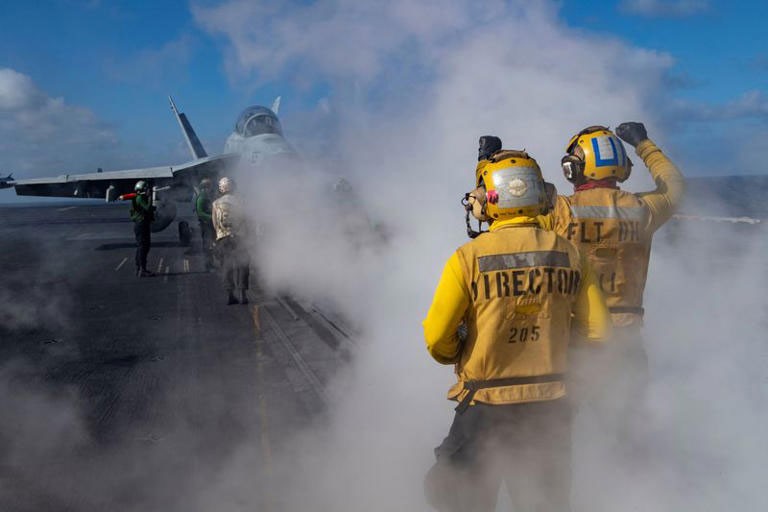Reuters
China's aircraft carriers play 'theatrical' role but pose little threat yet
Story by By Greg Torode, Eduardo Baptista and Tim Kelly • 3h ago - 5-5-2023
By Greg Torode, Eduardo Baptista and Tim Kelly
FROM SKI JUMPS TO CATAPULTS
As the Liaoning and Shandong gradually increase the tempo of their drills, China is preparing for sea trials of its next-generation carrier, the 80,000-tonne Fujian, state media reported last month. The Fujian is significantly larger, though conventionally powered, and will launch aircraft from electromagnetic catapults.
The ship, which the Pentagon report said could be operational by 2024, is expected to carry new variants of the J-15 jet fighter, replacing the existing model that foreign analysts consider underpowered.
"The Fujian, with its more modern capabilities, will be just another test bed for a good few years," said Collin Koh, a defence scholar at Singapore's S. Rajaratnam School of International Studies.
"It won't be until we see the next generation of carriers that the Chinese designs and the PLAN's intentions will really settle down."
The carrier program reflects the ruling Communist Party's aim of making the People's Liberation Army (PLA) a "world class" military by 2049, part of President Xi Jinping's vision of building "a great modern socialist country".
One indication of China's ambitions, the attaches said, will be if carriers built after the Fujian are nuclear-powered like U.S. ones, allowing global range.
A study published in December by the non-partisan U.S. Congressional Research Service noted that China would use its carriers to project power "particularly in scenarios that do not involve opposing U.S. forces" and "to impress or intimidate foreign observers".
Several countries operate aircraft carriers but the U.S. remains the most dominant, running 11 carrier battlegroups with global reach.
China, by contrast, could use its carriers primarily in the Asian theatre, working in tandem with submarines and anti-ship missiles to attempt to control its near seas.
The Shandong's appearance off Taiwan's east coast to stage mock strikes last month surprised some analysts, given the island's proximity to land-based airfields. But, in the short term at least, China's military would struggle to defend the carrier out in the western Pacific in a clash with U.S. and allied forces.
"China's objective with the deployment of the Shandong is clear, it is a symbol of its political anger" over U.S. engagement with Taiwan, said Yoji Koda, a retired admiral who commanded the Japanese fleet.
In a battle, he said, it "would be a very good target for U.S. and Japanese forces, and they would take it down at the very beginning."
A U.S. defence official, speaking on the condition of anonymity as they were not authorised to talk publicly, said while China had made progress with its carriers, it had yet to master operations in difficult conditions or how to protect the vessels.
One question was how the ships would be relevant in a conflict, the official said.
China's aircraft carriers play 'theatrical' role but pose little threat yet
Story by By Greg Torode, Eduardo Baptista and Tim Kelly • 3h ago - 5-5-2023
By Greg Torode, Eduardo Baptista and Tim Kelly
FROM SKI JUMPS TO CATAPULTS
As the Liaoning and Shandong gradually increase the tempo of their drills, China is preparing for sea trials of its next-generation carrier, the 80,000-tonne Fujian, state media reported last month. The Fujian is significantly larger, though conventionally powered, and will launch aircraft from electromagnetic catapults.
The ship, which the Pentagon report said could be operational by 2024, is expected to carry new variants of the J-15 jet fighter, replacing the existing model that foreign analysts consider underpowered.
"The Fujian, with its more modern capabilities, will be just another test bed for a good few years," said Collin Koh, a defence scholar at Singapore's S. Rajaratnam School of International Studies.
"It won't be until we see the next generation of carriers that the Chinese designs and the PLAN's intentions will really settle down."
The carrier program reflects the ruling Communist Party's aim of making the People's Liberation Army (PLA) a "world class" military by 2049, part of President Xi Jinping's vision of building "a great modern socialist country".
One indication of China's ambitions, the attaches said, will be if carriers built after the Fujian are nuclear-powered like U.S. ones, allowing global range.
A study published in December by the non-partisan U.S. Congressional Research Service noted that China would use its carriers to project power "particularly in scenarios that do not involve opposing U.S. forces" and "to impress or intimidate foreign observers".
Several countries operate aircraft carriers but the U.S. remains the most dominant, running 11 carrier battlegroups with global reach.
China, by contrast, could use its carriers primarily in the Asian theatre, working in tandem with submarines and anti-ship missiles to attempt to control its near seas.
The Shandong's appearance off Taiwan's east coast to stage mock strikes last month surprised some analysts, given the island's proximity to land-based airfields. But, in the short term at least, China's military would struggle to defend the carrier out in the western Pacific in a clash with U.S. and allied forces.
"China's objective with the deployment of the Shandong is clear, it is a symbol of its political anger" over U.S. engagement with Taiwan, said Yoji Koda, a retired admiral who commanded the Japanese fleet.
In a battle, he said, it "would be a very good target for U.S. and Japanese forces, and they would take it down at the very beginning."
A U.S. defence official, speaking on the condition of anonymity as they were not authorised to talk publicly, said while China had made progress with its carriers, it had yet to master operations in difficult conditions or how to protect the vessels.
One question was how the ships would be relevant in a conflict, the official said.
3 yr. ago


